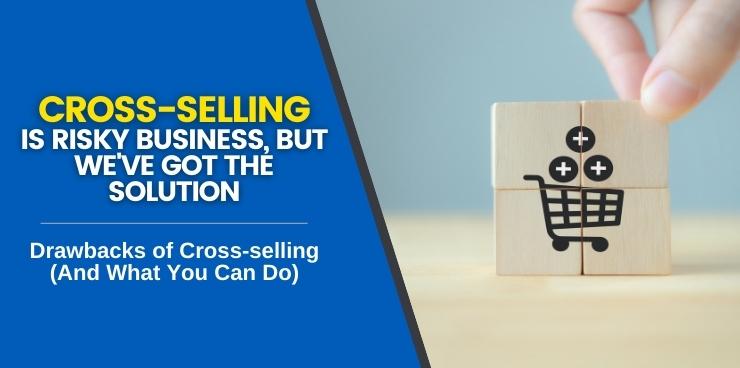As a business in the residential home services industry, finding new customers and increasing revenue will always be job one.
Electrical companies find it more difficult to retain regular clients, as a home may need occasional service, and the occasional upgrade, but otherwise has little in the way of maintenance like HVAC and plumbing companies do.
To really create a relationship with a customer that has a ripple effect of increasing sales, you need to have an effective sales strategy in place. One that many small businesses like to use is cross-selling.
When done right, cross-selling techniques can enhance the customer experience, improve customer satisfaction, and most importantly, increase revenue.
However, like any sales strategy, there are some potential drawbacks of cross-selling that you should be aware of before implementing it in your business.
In this article, we’ll take you through some common drawbacks and show you how you can overcome them so you can reap the benefits of cross-selling in your business.
Cross-Selling vs. Upselling
Cross-selling is a marketing technique used to encourage customers to buy related products or services. This is done by offering the customer additional products or services that complement the ones they have already purchased.
The main goal of cross-selling is to increase customer loyalty and lifetime value by expanding the customer relationship beyond the initial purchase. Many confuse cross-selling with upselling. However, there is a big difference between the two selling techniques.
Upselling is a marketing technique used to encourage customers to buy more expensive or upgraded versions of products or services. Just as in brick and mortar, eCommerce upselling generally occurs after the initial purchase has been made. The goal of upselling is to increase revenue per customer by selling higher-priced items or services.
For example, if you are a home renovations company and a customer calls to inquire about having new windows installed, you may try to upsell them by offering windows that are of higher quality or that come with a better warranty.
Cross-selling, on the other hand, is a marketing technique used to encourage customers to buy related products or services. For example, instead of offering higher-priced windows, you might cross-sell the customer by offering them a discount on new gutters if they purchase new windows.
The main difference between upselling and cross-selling is that upselling is about selling more expensive items or services while cross-selling is about selling related products or services.
Want to begin implementing cross-selling for your business? At Wizard of Sales®, our pricing strategies are designed to increase your customer’s order value without breaking the bank.
Book a demo with us today!
The Drawbacks of Cross-Selling
Just like in Star Wars, there is always a dark side. In this case, we’re talking about cross-selling, obviously.
When you look at the functional purpose of cross-selling products and services, it seems like common sense: your customers buy this, so they might want to buy this other thing too.
You’re just helping them out by providing related products that complement their purchase. But as you might expect, there’s a potential downside to this selling strategy – and it can cost you dearly if you’re not careful.
Harvard Business Review analyzed customer data sets of five Fortune 1000 companies over the period of four to seven years. Although they found that the average profit from cross-buying customers was higher than those who don’t, they discovered that one in five cross-buying customers is unprofitable.
That may not sound like a lot, but that is 70 percent of a firm’s total “customer loss” – when the cost of marketing and goods exceeds total revenue. And believe it or not, the more cross-buying your customer does, the more money you stand to lose. This is one of those times we talk about growth costing money.
So how does this happen? And what can you do to nip it in the bud? Here are some variations of these types of customers with a solution for each.
Warranty and Callbacks
These are the customers that call customer service for every little thing – even things that they could easily resolve themselves. The more they cross-buy, the more service they need, which will make your costs rise along with it.
Solution: Let them know that you’re always happy to help, but creating a space where your customers can get helped without needing to talk to customer service is key. Try implementing a searchable FAQ, a product wiki on your website, or even implement AI or bots to handle it for you.
Product Returners
These are the customers that return more items than they keep. They’re a nightmare for any company offering returns, and if you’re selling physical goods, you need to watch out for them as they will return that revenue just like they returned the product. All of this costs money in handling, unboxed goods, and bank fees.
Solution: Make sure your returns policy is airtight, and be sure to enforce it. You can also try to upsell these customers by offering them an extended warranty, replacement product, or store credit in lieu of a cash refund.
Discount Lovers
These are the customers that are always looking for a deal. They’re the ones that wait for sales, use coupons, and incessantly haggle with you over price. They avoid regular-priced items like the plague which can plummet revenue.
Solution: Try focusing less on selling the price and more on selling the value. If you can show these customers how your product is worth the price, then they’re more likely to make a purchase. This is particularly true when it comes to selling club memberships for the sole reason that they receive a discount. If you fail to outline all of the other benefits, you are doing everyone a disservice.
 Tiny Spenders
Tiny Spenders
Similar to discount lovers, these customers are always looking for ways to spend less. They might be more open to making a purchase if you can offer them a bundle deal or package deal. These shoppers tend to cherish their money more than their time, and are more likely to buy the cheapest thing rather than the best solution.
Solution: Try upselling these customers by bundling items together or throwing in an additional item for free. This will make them feel like they’re getting more bang for their buck and encourage them to make a purchase.
Of course, the magnitude of these problems varies from company to company, industry to industry, and product to product. Nevertheless, it’s important to be aware of the potential risks and take steps to mitigate them.
Most Common Cross-Selling Methods
There is more than one way to cross-sell. The most common methods are:
- Offer Additional Services: You can increase the value of your product by bundling it with other complementary services. For example, an HVAC company could offer its customers a service plan that includes regular maintenance check-ups.
- Bundle Sales: As with services, you can increase your profits by selling multiple products together. For example, if you’re selling a pool, you could offer a package that includes the pool, chemicals, and a maintenance plan.
- Create a Loyalty Program: A loyalty program is a great way to increase customer retention while also providing an opportunity to cross-sell. For example, you could offer a discount to customers who purchase a certain amount of products within a certain time period.
- Educate Your Clients: If your clients understand the value of your products, they’re more likely to purchase them. Make sure you take the time to educate your clients on the features and benefits of your products.
There are many different methods you can use to cross-sell your products. The most important thing is to find a method that works well for your business.
 What Does Cross-Selling Look Like In Action?
What Does Cross-Selling Look Like In Action?
Now that you have a thorough insight on what cross-selling is – the good and the bad – let’s get Hollywood and show you this sales strategy in action.
You’re an HVAC company. You’ve been in the business for years, and you’re well-known in your area for providing quality service. You have a strong brand presence, and you’re always looking for new ways to attract customers and grow your business.
One day, you get a call from a new homeowner who is interested in getting their furnace serviced. They’ve seen your ads and are impressed with your reputation. After servicing their heating and cooling system, you take the opportunity to cross-sell them on a triple deep clean.
You explain to them that since you’re already there, it would be a good idea to get their condenser, evaporator coil, and blower motor back to factory fresh again. They’re penny-pinchers, but you sell them on the idea of a package deal for doing all three. You show them how important it is to make sure everything in their system is running smoothly. The customer agrees and you schedule a time to come back and do the work.
Boom. Cut scene.
This is just one example of how cross-selling can work in the real world. By providing quality service and being proactive, you can upsell your customers on additional services that they may need. This not only benefits them but also helps you grow your business.
No More Risky Business
There are a lot of opportunities to use cross-selling as a residential home service company. Remember to keep in mind the risks that are involved so you don’t put your business in danger. But when you play your cards right, cross-selling is a powerful tool to help you close more deals and increase your bottom line.
If you wanna skip the trial and error though, we’d be happy to serve you at Wizard of Sales®.
Book a demo with us today to learn more.



 Tiny Spenders
Tiny Spenders What Does Cross-Selling Look Like In Action?
What Does Cross-Selling Look Like In Action?